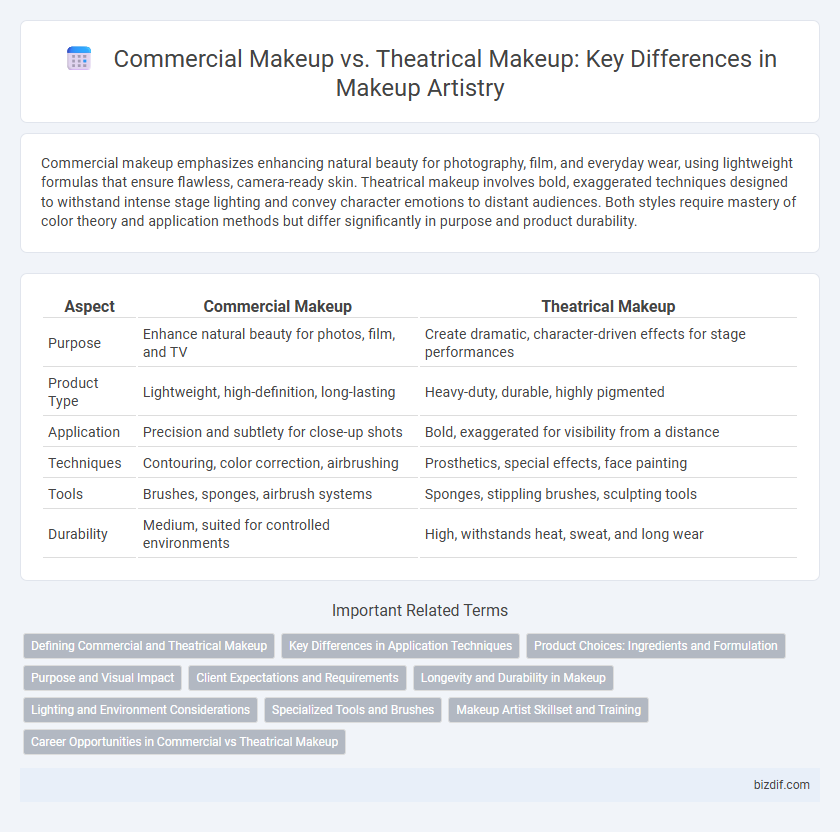Commercial makeup emphasizes enhancing natural beauty for photography, film, and everyday wear, using lightweight formulas that ensure flawless, camera-ready skin. Theatrical makeup involves bold, exaggerated techniques designed to withstand intense stage lighting and convey character emotions to distant audiences. Both styles require mastery of color theory and application methods but differ significantly in purpose and product durability.
Table of Comparison
| Aspect | Commercial Makeup | Theatrical Makeup |
|---|---|---|
| Purpose | Enhance natural beauty for photos, film, and TV | Create dramatic, character-driven effects for stage performances |
| Product Type | Lightweight, high-definition, long-lasting | Heavy-duty, durable, highly pigmented |
| Application | Precision and subtlety for close-up shots | Bold, exaggerated for visibility from a distance |
| Techniques | Contouring, color correction, airbrushing | Prosthetics, special effects, face painting |
| Tools | Brushes, sponges, airbrush systems | Sponges, stippling brushes, sculpting tools |
| Durability | Medium, suited for controlled environments | High, withstands heat, sweat, and long wear |
Defining Commercial and Theatrical Makeup
Commercial makeup emphasizes enhancing natural beauty for media such as television, film, and advertising, aiming for realistic and camera-ready looks that highlight facial features under controlled lighting. Theatrical makeup involves dramatic and exaggerated applications designed to convey characters and emotions on stage, often using bold colors and prosthetics to ensure visibility from a distance. Both disciplines require specialized techniques but serve distinct purposes in visual storytelling and audience impact.
Key Differences in Application Techniques
Commercial makeup emphasizes a natural, flawless finish suited for high-definition cameras, using lightweight foundations and subtle contouring to enhance features without looking heavy. Theatrical makeup requires bold, exaggerated techniques with heavier products to ensure visibility under stage lights, often incorporating prosthetics and vivid colors to convey character and emotion. Application in theatrical makeup involves layering and blending that withstand intense lighting and distance, whereas commercial makeup focuses on precision and smoothness for close-up visuals.
Product Choices: Ingredients and Formulation
Commercial makeup prioritizes lightweight, long-wearing formulas with skin-friendly ingredients such as hyaluronic acid and antioxidants to ensure comfort and durability for everyday wear. Theatrical makeup uses heavier, highly pigmented products with waxes, silicones, and thick emulsifiers designed for intense coverage and longevity under stage lights and harsh conditions. Formulations in theatrical makeup often include waterproof and sweat-resistant compounds to maintain appearance during extended performances.
Purpose and Visual Impact
Commercial makeup emphasizes enhancing natural beauty and camera readiness for advertising, fashion, and beauty campaigns, focusing on flawless, polished looks that photograph well. Theatrical makeup prioritizes dramatic transformations and exaggerated features to convey character and emotion clearly to live audiences, often involving bold colors and textures that withstand stage lighting. Both styles serve distinct visual impacts aligned with their intended settings--commercial for realism and subtlety, theatrical for visibility and storytelling.
Client Expectations and Requirements
Commercial makeup emphasizes flawless, natural-looking finishes tailored for photography, advertising, and television, meeting client expectations for subtle enhancement and brand alignment. Theatrical makeup requires bold, exaggerated techniques designed to withstand stage lighting and convey characters convincingly to live audiences, fulfilling demands for durability and dramatic effect. Clients in commercial settings prioritize quick application, adaptability, and seamless appearance, while theatrical clients expect transformative artistry that supports narrative storytelling and visibility from a distance.
Longevity and Durability in Makeup
Commercial makeup prioritizes a natural finish with moderate longevity, designed to withstand daily wear and multiple lighting conditions typical in photography and video. Theatrical makeup emphasizes maximum durability and resistance to sweat, heat, and extended performance hours, using heavier products to ensure stability under stage lights. Both require specialized formulations, but theatrical makeup demands superior endurance to maintain character consistency throughout intense, live scenarios.
Lighting and Environment Considerations
Commercial makeup is designed for controlled lighting environments such as studios where soft, even light enhances natural skin tones, requiring products with a matte or semi-matte finish to reduce shine and create flawless, camera-ready looks. Theatrical makeup must withstand intense, varied stage lighting that can be harsh or colored, necessitating highly pigmented, long-lasting formulations that remain visible from a distance and under hot lights. Environmental factors like humidity and sweat also demand waterproof and smudge-proof makeup in theater settings to maintain character appearance throughout performances.
Specialized Tools and Brushes
Commercial makeup employs lightweight, precision brushes designed for smooth application and natural finishes, often using synthetic fibers optimized for liquid and cream products. Theatrical makeup requires robust, multi-purpose brushes and sponges, crafted from both synthetic and natural fibers, to handle heavy pigments, prosthetics, and detailed character transformations under stage lighting. Specialized tools such as stippling brushes, fused fiber brushes, and costume-specific applicators are essential in theatrical settings to achieve durability and dramatic effects.
Makeup Artist Skillset and Training
Commercial makeup artists develop skills in creating flawless, camera-ready looks suitable for photography and advertising, emphasizing techniques that enhance natural features and withstand high-definition visuals. Theatrical makeup artists require advanced training in special effects, prosthetics, and dramatic character creation to ensure visibility and impact from stage distances under various lighting conditions. Mastery in both disciplines demands continuous education in product knowledge, color theory, and application methods tailored to specific media environments.
Career Opportunities in Commercial vs Theatrical Makeup
Commercial makeup offers diverse career opportunities in fashion, advertising, film, and television, emphasizing natural and camera-ready looks tailored for close-up shots. Theatrical makeup careers specialize in stage and live performances, requiring skills in elaborate character creation, prosthetics, and durable application under intense lighting. Both fields demand artistic talent and technical expertise, but commercial makeup artists often work on high-profile media projects, while theatrical artists thrive in dynamic live performance environments.
Commercial Makeup vs Theatrical Makeup Infographic

 bizdif.com
bizdif.com